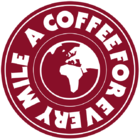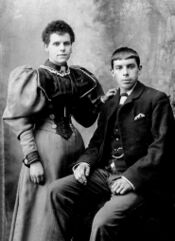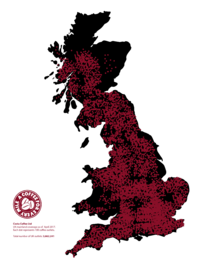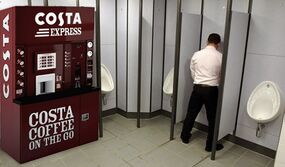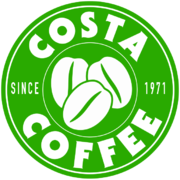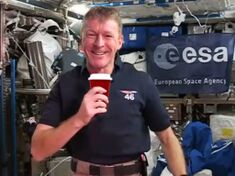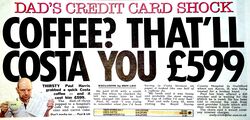Costa Coffee
Costa Coffee is a multinational coffee-house chain that operates over seven million coffee shops across 127 countries. Costa Coffee is famed for its motto, "A coffee for every mile," and rather less for its coffee. Costa Coffee's business strategy is to have a Costa Coffee shop "within view from anywhere in the UK."
History
The Costa Coffee website provides an insight into its history:
| “ | After reading an article about dwindling coffee shops in London, twins Mildred and Mortimer Costa seized the business opportunity to start a coffee brand and began importing raw coffee from Peru. Their practice was simple; order one tonne of coffee per month, extract the coffee seeds from the fruit by hand and then roast it in their mother’s kitchen oven. Less than two years after importing their first tonne of coffee, the stump-fingered Costa twins founded ’’Costa’s Roasted Seeds’’ in London in 1971. After three years of roasting, the Costas finally managed to accrue enough money to open their first coffee shop in central London. Costa Coffee™ as we know it was born. Its doors opened in August 1974 and was an immediate success. By 1983 it had expanded its franchise to 35 other locations across London’s suburbs and had established its now-famous branding. | ” |
Prime directive
To dominate the burgeoning UK coffee market, Costa Coffee developed an ambitious business strategy in 2009, setting itself near-impossible targets to meet by 2025. Its primary goal is to open as many stores as it can over the next 20 years. Like a viral outbreak, it has spread across the UK and infected many major business and retail outlets.
Costa Coffee can be purchased from inside petrol stations, public toilets, super-markets, WH Smiths, Homebase, public toilets, high schools, national embassies, petrol stations, independent cobblers, and public toilets. Sub-units operate in a variety of different locations around the country including public toilets, international airports, bus stops, train stations, social khazis, and public toilets. Many of Costa’s smaller franchises rely on the Costa Insta-Machine, a self-service device found frequently in communal shitters.
Expansion plans
Costa Coffee has over 89,000 coffee shops in the UK, which works out to one per half-mile on Britain’s roads. In keeping with its business strategy, Costa plans to build another 80,000 coffee shops over the next 8 years. According to Costa business strategist Paul Desmond: "Costa Coffee hopes to have a coffee shop within view from anywhere in the country by 2025."
Costa Coffee's international activities frequently garner attention. The Namibian government recently confirmed that Costa Coffee had sought to buy its capital city Windhoek outright.
Costa products
Costa serves a wide variety of coffee products, ranging from traditional hot drinks such as Cappuccino, Africano, and Brown, to more modern drinks such as Steam, Mocha-Cinquecento, and new addition "The Baby Costa." A wide variety of foodstuffs are also sold in store, such as cakes, pies, kebabs, cheese toasties, and needlessly enlarged low-quality biscuits. Costa also offers a wide selection of expensive oil-rich muffins. All food sold in stores has been specifically developed for the impossible task of bringing out the flavour of the coffee.
Costa Express™
Developed especially for Costa Coffee, the Costa Express Insta-Machine is installed directly into a wall and usually found in small shops or public toilets. Operating much like a prophylactic dispenser, the Insta-Machine requires the excited coffee user to select a style, appropriate size, and quantity, before inserting coins. The machine then repeats back the order to the user for confirmation. It takes an average of 2 minutes for the machine to brew the user's order, which is then dispensed into a small compartment at the bottom of the machine.
Reports of the machine taking users' money and not dispensing the goods are increasingly common, as are broken machines clogged with spunk. In the roasting process, Costa uses an undisclosed mix of robusta, arabica, dried green lentils, and grass seed in the roasting and smoking process. Once the seeds are fully smoked, they are stored in huge wooden casks called "winnets." The winnets are then loaded onto pallets and transported around the country. The use of both green lentils and grass seed in Costa's coffee helps to create its mild flavour, trademark ammonia-laced bouquet, and abundant fluorescent orange crema floating on the top of each drink.
Branding
Costa Coffee's logo and visual branding identity has changed little since its inception. Costa has maintained its maroon palette throughout its marketing since 1971 but has introduced other colours such as "pus green" for special promotions.
Logo
The current logo was introduced in April 2017 and features the motto, "A coffee for every mile" instead of the traditional text. White, monochromatic, full colour and "La-Forge" gamut versions are in circulation. Special versions of the logo — one comprised of water vapour and the other of negatively charged photons — are in development in preparation for a permanent display in the sky and on the moon, respectively.
Traditional print media such as advertising posters, pretentious magazines, ugly wall art, disposable coffee-carrying vessels, and dissolvable lip dabbers feature heavily in Costa branches across the world. Costa’s voracious infatuation with printing has commissioned 20 million prints of various design works each year, the equivalent to Hoovering up all the trees in Sherwood Forest. Costa’s recent expansion into high schools has seen them develop a wide variety of print-related branding aimed at children, including school books, pens and pencils, calculators, and rolling papers.
Polling
In 2009, Costa Coffee conducted a poll that it proudly declared showed that 7 out of 10 people "prefer Costa Coffee over Starbucks." Diplomatically, the pollsters, hired by Costa, declined to report that the poll was conducted completely inside Costa shops. Still, it is a small asset that only 3 in 10 patrons do not like the product.
Space coffee
British astronaut and professional smiley face Tim Peake was officially sponsored by Costa Coffee for his recent trip to the International Space Station, a product placement hoped to be more successful and lucrative than jars of Tang aboard Project Gemini. A version of the Costa Coffee logo was stitched into the shoulder of Peake's space suit, allowing Costa Coffee to officially become the first coffee chain to have left the planet.
In exchange for Costa Coffee funding the expansion of its coffee shops into schools, Peake was required to advertise Costa during the live reports of his activities on the Space Station. On returning to Earth, Peake and Costa Coffee public relations representative Edna Minty discussed the condition and flavour of the coffee, as well as Peake's incipient personal dependence on it. Peake remarked that its flavour was "remarkably unchanged" despite spending 20 hours in a vacuum and having been frozen and defrosted multiple times. Peake also remarked that, whilst on his vacation abroad, his addiction "abated substantially," to the point that he consumed only 15 cups a day.
Fun facts
- Costa’s chief coffee taster Gennaro Pelliccia, whose job is to watch customer reactions to tasting Costa Coffee, recently had his eyes insured for £10 million with Lloyd’s of London in 2009.
- It's estimated that over 26 million Brits are dependent on Costa's coffee to function normally in society.
- The "Costa Coffee For Schools" campaign was originally initiated by Jamie Oliver but only received political backing and support when likable ex-education minster Michael Gove joined the movement.
- Like its competitor, Caffè Nero, Costa also donates free coffee to the homeless and is solidly represented on the streets of Britain. Costa also donates used coffee grinds to schools for disabled children to play with.
See also
| Featured version: 20 July 2017 | |
| This article has been featured on the main page. — You can vote for or nominate your favourite articles at Uncyclopedia:VFH. | |
